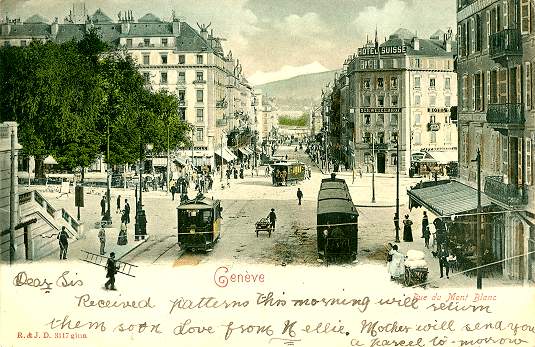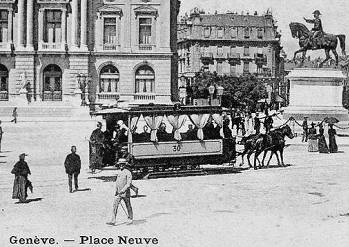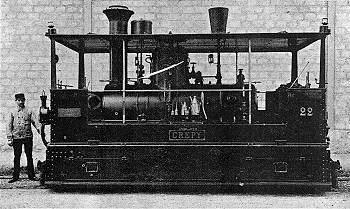

In the main postcard (card 3117 from German publisher Roemmler & Jonas, Dresden) we are looking down Rue du Mont Blanc from the railway station in Place de Cornavin around 1900, and can see two tramways. The card has an undivided back and was posted in 1904. On the left of the view is standard gauge electric car 98 of the Tramways Suisses, one of a batch of 8 built in 1894 by Schweizerische Industrie Gesellschaft (SIG) of Neuhausen. They each had a single 30 hp motor from Compagnie de l'Industrie Électrique et Mécanique of Geneva, and seated 12 with 18 standing passengers. On the right is a metre gauge steam tram and trailers of Chemin de Fer à Voie Étroite. The track on the far left would still have been used by Tramways Suisses horse trams at this date.
Extracted from card number 657 III from Charnaux Frère & Cie of Geneva, the small view below shows such a Tramways Suisses horse tram, number 30, crossing the Place Neuve in around 1898. This tram was from a batch of 10 (numbered 28-37) built in 1877 for the Compagnie des Tramways de Genève by SIG. They were open, with unglazed windows fitted with curtains, and seated 20 with 26 standing passengers.
The final small image comes from "The Railway World" of January 1895. This is loco number 22, named "Crépy", of Chemin de Fer à Voie Étroite, the last one supplied to them by Schweizerische Locomotiv und Maschinenfabrik of Winterthur in 1891. These locos were 0-6-0 and had two cylinders, each 24 cm diameter with 36 cm stroke, and 75 cm diameter wheels. Unlike British steam trams, they did not have condensers. Loco 22 survived until 1915, in its later days pulling goods trains.
On 19th June 1862, under a concession granted to Messrs. Ch. Burn and Company, the first horse tramway in Switzerland was opened from Place Neuve in Geneva to Carouge. This was 2.5 km in length and built to standard gauge. This company soon became the Société des Tramways de Genève à Carouge. On September 12th 1864 a second company opened a 2.8 km line from Cours de Rive to Chêne-Bourgeries. This became the Société des Tramways de Genève à Chêne.
 In 1876 a new company, Compagnie des Tramways de Genève, took over the existing standard gauge horse tramways and in the same year connected the two lines and also built a route from Mollard to Montbrillant. At the end of that year the company changed to Compagnie Générale des Tramways Suisses (TS), with a view to controlling tramways in other parts of Switzerland and indeed outside. An extension in 1882 joined the main line to Moillesulaz, forming what was to become the current and long lived route 12. Other extensions and new routes were developed including that on from Moillesulaz to Annemasse in France and a separate line from there to Etrembières. In 1877 TS started experiments with a steam tram and by 1892 had 8 locomotives built by Schweizerische Locomotiv und Maschinenfabrik of Winterthur (SLM). Steam replaced horses on most routes, but the line to the railway station at Cornavin along Rue du Mont Blanc remained horse drawn due to the light bridge construction of the Pont du Mont Blanc.
In 1876 a new company, Compagnie des Tramways de Genève, took over the existing standard gauge horse tramways and in the same year connected the two lines and also built a route from Mollard to Montbrillant. At the end of that year the company changed to Compagnie Générale des Tramways Suisses (TS), with a view to controlling tramways in other parts of Switzerland and indeed outside. An extension in 1882 joined the main line to Moillesulaz, forming what was to become the current and long lived route 12. Other extensions and new routes were developed including that on from Moillesulaz to Annemasse in France and a separate line from there to Etrembières. In 1877 TS started experiments with a steam tram and by 1892 had 8 locomotives built by Schweizerische Locomotiv und Maschinenfabrik of Winterthur (SLM). Steam replaced horses on most routes, but the line to the railway station at Cornavin along Rue du Mont Blanc remained horse drawn due to the light bridge construction of the Pont du Mont Blanc.
On 22nd September 1894 TS opened a new route from Petit-Saconnex to Champel via Cornavin, Pont de l'Ile and Place Neuve using electric traction and in 1896 electrified the main Carouge to Moillesulaz route. By 1900 the total of standard gauge tramways worked by horse, steam and electric traction was about 20 km. The depot was at La Cluse.
 In 1888 the Société Genevoise de Chemin de Fer à VoieÉtroite (VE) was formed to build a network of metre gauge steam tramways in the city of Geneva and the surrounding districts. By 1900 the VE were operating 76 km of route servings such places as Bernex, Laconnex, Grand-Lancy, Vernier, Chancy, Veigy, Jussy and Vandoeuvres, with some sections running into France. They had 22 locomotives built by SLM and in 1897 added 5 Serpollet boilered self contained steam trams from Maschinenfabrik of Basel. The depot was located at Acacias.
In 1888 the Société Genevoise de Chemin de Fer à VoieÉtroite (VE) was formed to build a network of metre gauge steam tramways in the city of Geneva and the surrounding districts. By 1900 the VE were operating 76 km of route servings such places as Bernex, Laconnex, Grand-Lancy, Vernier, Chancy, Veigy, Jussy and Vandoeuvres, with some sections running into France. They had 22 locomotives built by SLM and in 1897 added 5 Serpollet boilered self contained steam trams from Maschinenfabrik of Basel. The depot was located at Acacias.
Formed in 1899, the Compagnie Genevoise des TramwaysÉlectrique (CGTE) took over the TS in 1900 and the VE in 1901. They then set about electrifying all the tramways and converting those of TS to metre gauge, to form a unified city-wide system. CGTE proceeded to open new routes including those to Sécheron, Versoix and Hermance. The main depot (today the trolleybus depot) was at Jonction. By 1920 there were 119 km of line with 15 routes and a fleet of about 145 trams. Geneva was then the largest tram network in Switzerland.
Meanwhile, in 1887 yet another company was formed, the Chemin de Fer Genève - Veyrier, with metre gauge steam lines, later electrified but not absorbed into the CGTE until 1936.
From 1925 the Geneva tramways started to decline. The long suburban routes were already losing money. Motor buses were being introduced in some quantity and tram routes started to be withdrawn. Over the next ten years or so about half the system had gone. From 1942 onwards some tram routes began to be replaced by trolleybuses. By 1969 only one route remained, route 12 Carouge to Moillesulaz, a situation that was to continue for nearly 20 years. However, in 1988 there was a referendum when the people voted for an expansion of the tramway network. By 2007 there were six routes, with extensions and other new routes to follow.
![]() After this postcard do you fancy a Swiss fondue? Then try the Fond-U-Like fondue website.
After this postcard do you fancy a Swiss fondue? Then try the Fond-U-Like fondue website.
![]() Go to Postcard Of The Month Index
Go to Postcard Of The Month Index